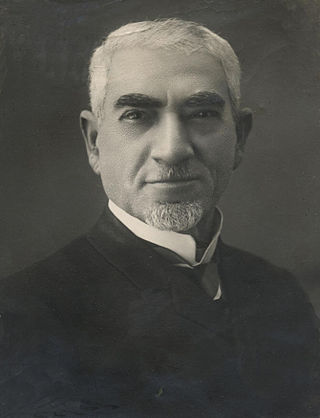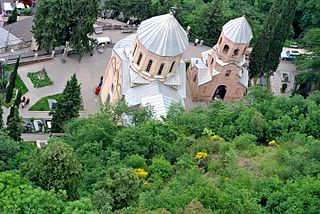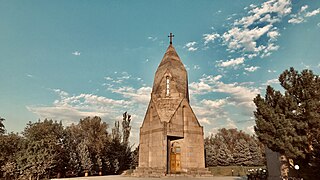Related Research Articles
Pantheon may refer to:

A mausoleum is an external free-standing building constructed as a monument enclosing the interment space or burial chamber of a deceased person or people. A mausoleum without the person's remains is called a cenotaph. A mausoleum may be considered a type of tomb, or the tomb may be considered to be within the mausoleum.

Michael Hovhannisyan, known by the pen name Nar-Dos, was an Armenian writer.

Ardahan is a city in northeastern Turkey, near the Georgian border. It is the seat of Ardahan Province and Ardahan District. Its population is 22,927 (2021).

Joseph Mackey Brown was an American politician. He served two non-consecutive terms as the 59th governor of Georgia, the first from 1909 to 1911 and the second from 1912 to 1913. He has also been posthumously implicated as one of the ringleaders in the lynching of Leo Frank.

The Holy Trinity Cathedral of Tbilisi, commonly known as Sameba, is the main cathedral of the Georgian Orthodox Church located in Tbilisi, the capital of Georgia. Constructed between 1995 and 2004, it is the third-tallest Eastern Orthodox cathedral in the world and one of the largest religious buildings in the world by total area. Sameba is a synthesis of traditional styles dominating the Georgian church architecture at various stages in history and has some Byzantine undertones.

Yerablur or Yerablur Military Pantheon is a military cemetery located on a hilltop in the outskirts of Yerevan, Armenia. Since 1988, Yerablur has become the burial place of Armenian soldiers who died during the Nagorno-Karabakh conflict.

The Kingdom of Tashir-Dzoraget, alternatively known as the Kingdom of Lori or Kiurikian Kingdom by later historians, was a medieval Armenian kingdom formed in the year 979 by the Kiurikian dynasty, a branch of the Bagratuni dynasty, as a vassal kingdom of the Bagratid Kingdom of Armenia. The first capital of the kingdom was Matsnaberd, currently part of modern-day Azerbaijan.

The Mtatsminda Pantheon of Writers and Public Figures is a necropolis in Tbilisi, Georgia, where some of the most prominent writers, artists, scholars, and national heroes of Georgia are buried. It is located in the churchyard around St David’s Church "Mamadaviti" on the slope of Mount Mtatsminda and was officially established in 1929. Atop the mountain is Mtatsminda Park, an amusement park owned by the municipality of Tbilisi.

Shengavit, is one of the 12 districts of Yerevan, the capital of Armenia, located at the southwestern part of the city. It has common borders with the districts of Malatia-Sebastia, Kentron, Erebuni and Nubarashen. Ararat Province forms the southern borders of the district.

The Armenian Pantheon of Tbilisi, also known as Khojivank or Khojavank, is an Armenian architectural complex in north-eastern part of Avlabari district of Tbilisi, Georgia. Many notable Armenian writers, artists and public figures are buried there.

The Lower Bethlemi Church(Georgian: ქვემო ბეთლემის ეკლესია), also known as the Church of Saint Stepanos of the Holy Virgins or Koosanats Sourb Stepanos Vank) – is a 14th–19th-century church at the foot of Narikala fortress in Old Tbilisi, Georgia. It was rebuilt between 1868 and 1870 and operated as an Armenian church. In 1988 it was given to the Georgian Orthodox and its Armenian identity was "Georgianized" in 1991.

The Armenian alphabet is an alphabetic writing system used to write Armenian. It was developed around 405 AD by Mesrop Mashtots, an Armenian linguist and ecclesiastical leader. The system originally had 36 letters; eventually, three more were adopted. The alphabet was also in wide use in the Ottoman Empire around the 18th and 19th centuries.

The Panteón Nacional Román Baldorioty de Castro is a tract of land in Barrio Segundo of the city of Ponce, Puerto Rico, originally designed as the city's cemetery, but later converted into what has come to be a famous burial place. Established in 1842, it is Puerto Rico's first national pantheon. It is the only cemetery dedicated as a museum in Puerto Rico and the Caribbean. Prior to being dedicated as a Panteón Nacional, it was known as Cementerio Viejo or as Cementerio Antiguo de Ponce, and is listed under that name on the U.S. National Register of Historic Places. The Pantheon is named after Román Baldorioty de Castro, a prolific Puerto Rican politician, and firm believer of Puerto Rican autonomy and independence. His remains are located here. The Pantheon also houses a small museum about the history of autonomism in the Island, and it is currently used both as a park and a venue for the expression of culture and the arts. It is called the Museo del Autonomismo Puertorriqueño.

Komitas Park and Pantheon is located in Yerevan's Shengavit District, on the right side of the main Arshakunyats Avenue, in Armenia. It was formed in 1936 after the demolition of the "Mler" cemetery and its historic chapel.
The Saburtalo Pantheon is a burial site in Tbilisi, Georgia, where some of the most prominent scientists and cultural activities are buried. It was opened in the 1970s. It consists of old (closed) and new pantheons.
The Didube Pantheon is a cemetery in Tbilisi, Georgia, where some of the most prominent writers, artists, scholars, scientists and political activists of Georgia are buried. These include Zurab Zhvania (1963–2005), who served as Prime Minister of Georgia in 2004. The cemetery was opened in 1939. The pantheon is located in the Didube District.

Vank or Vangli is a village de facto in the Martakert Province of the breakaway Republic of Artsakh, de jure in the Kalbajar District of Azerbaijan, in the disputed region of Nagorno-Karabakh. The village has an ethnic Armenian-majority population, and also had an Armenian majority in 1989. The 13th-century Gandzasar Monastery, and the 9th-century Khokhanaberd fortress are located near Vank.

St. Vartanants Martyrs Church is the Armenian Apostolic Church in the Malatia-Sebastia District of Yerevan, the capital of Armenia. It is located on the Yerablur hill, right of the Yerevan-Echmiadzin highway.
References
- ↑ (in Russian) В Тбилиси закрывается Дидубийский пантеон писателей и общественных деятелей
- ↑ (in Armenian) RAA գիտական ուսումնասիրություններ Գիրք II. Վրաց պետական քաղաքականությունը և հայ մշակույթի հուշարձանները (1988–1999), Դիվան վավերագրերին և լուսանկարների, կազմող Սամվել Կարապետյան. ISBN 5808001447 ԳՄԴ 85.113 (2Հ)
- ↑ The Chronicle of a Long Appropriation Process